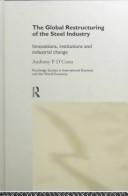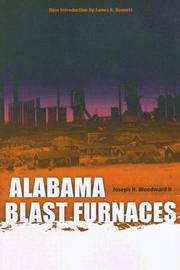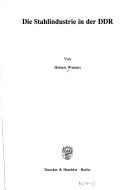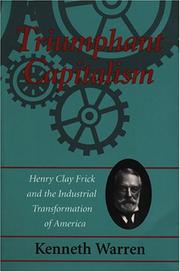| Listing 1 - 10 of 29 | << page >> |
Sort by
|
Book
ISBN: 1536112453 9781536112450 1617611905 9781617611902 Year: 2011 Publisher: New York
Abstract | Keywords | Export | Availability | Bookmark
 Loading...
Loading...Choose an application
- Reference Manager
- EndNote
- RefWorks (Direct export to RefWorks)
Steel industry and trade --- Ferrous metal industries --- Metal trade --- Iron industry and trade --- Algeria --- Economic conditions
Book
ISBN: 3428457722 3428057724 Year: 1985 Publisher: Duncker & Humblot
Abstract | Keywords | Export | Availability | Bookmark
 Loading...
Loading...Choose an application
- Reference Manager
- EndNote
- RefWorks (Direct export to RefWorks)
Steel industry and trade --- Government policy --- Congresses. --- Ferrous metal industries --- Metal trade --- Iron industry and trade --- Rohstoffmarkt --- Wirtschaftspolitik

ISBN: 0415148278 0585461996 0203425227 1134753101 1280111011 0429231539 9780203425220 9780415148276 9780585461991 9786610111015 6610111014 9781134753109 9781134753055 1134753055 9781134753093 1134753098 9780429231537 9781280111013 Year: 1999 Publisher: London New York Routledge
Abstract | Keywords | Export | Availability | Bookmark
 Loading...
Loading...Choose an application
- Reference Manager
- EndNote
- RefWorks (Direct export to RefWorks)
Using case studies from USA, Japan, South Korea, Brazil and India, this work explains how and why the steel industry has shifted from the advanced capitalist countries to the late industrializing countries.
Steel industry and trade. --- Steel industry and trade --- Industries --- Business & Economics --- Government policy --- Government policy. --- Ferrous metal industries --- Metal trade --- Iron industry and trade

ISBN: 0817354328 0817381015 9780817381011 9780817354329 Year: 2007 Publisher: Tuscaloosa University of Alabama Press
Abstract | Keywords | Export | Availability | Bookmark
 Loading...
Loading...Choose an application
- Reference Manager
- EndNote
- RefWorks (Direct export to RefWorks)
This work is the first and remains the only source of information on all blast furnaces built and operated in Alabama, from the first known charcoal furnace of 1815 (Cedar Creek Furnace in Franklin County) to the coke-fired giants built before the onset of the Great Depression. Woodward surveys the iron industry from the early, small local market furnaces through the rise of the iron industry in support of the Confederate war effort, to the giant internationally important industry that developed in the 1890's. The bulk of the book consists of individual illustrated histories
Blast furnaces --- Cast-iron --- Iron industry and trade --- Ferrous metal industries --- Pig-iron --- Metal trade --- Steel industry and trade --- Iron --- Decorative cast-ironwork --- Iron founding --- Smelting furnaces
Book
ISBN: 0128042354 0128042338 9780128042359 9780128042335 9780128042335 Year: 2016 Publisher: Amsterdam
Abstract | Keywords | Export | Availability | Bookmark
 Loading...
Loading...Choose an application
- Reference Manager
- EndNote
- RefWorks (Direct export to RefWorks)
Although the last two generations have seen an enormous amount of attention paid to advances in electronics, the fact remains that high-income, high-energy societies could thrive without microchips, etc., but, by contrast, could not exist without steel. Because of the importance of this material to comtemporary civilization, a comprehensive resource is needed for metallurgists, non-metallurgists, and anyone with a background in environmental studies, industry, manufacturing, and history, seeking a broader understanding of the history of iron and steel and its current and future impact on society. Given its coverage of the history of iron and steel from its genesis to slow pre-industrial progress, revolutionary advances during the 19th century, magnification of 19th century advances during the past five generations, patterns of modern steel production, the ubiquitous uses of the material, potential substitutions, advances in relative dematerialization, and appraisal of steel's possible futures, Still the Iron Age: Iron and Steel in the Modern World by world-renowned author Vaclav Smil meets that need.
Iron --- Steel --- History. --- Metallurgy. --- Iron industry and trade. --- Steel industry and trade. --- Social aspects. --- Ferrous metal industries --- Metal trade --- Iron industry and trade --- Steel industry and trade --- Native element minerals --- Transition metals --- Siderophile elements --- Eisen- und Stahlindustrie. --- Eisenherstellung. --- Stahlherstellung.

ISBN: 342807341X 3428473418 Year: 1992 Publisher: Duncker & Humblot
Abstract | Keywords | Export | Availability | Bookmark
 Loading...
Loading...Choose an application
- Reference Manager
- EndNote
- RefWorks (Direct export to RefWorks)

ISBN: 3428484150 3428084152 Year: 1995 Publisher: Duncker & Humblot
Abstract | Keywords | Export | Availability | Bookmark
 Loading...
Loading...Choose an application
- Reference Manager
- EndNote
- RefWorks (Direct export to RefWorks)
Steel industry and trade --- Industrial productivity --- Management. --- Productivity, Industrial --- TFP (Total factor productivity) --- Total factor productivity --- Industrial efficiency --- Production (Economic theory) --- Ferrous metal industries --- Metal trade --- Iron industry and trade --- Protektionismus --- Wirtschaftspolitik --- Handelshemmnis --- Eisen- und Stahlindustrie

ISBN: 0822972212 9780822972211 0822938898 9780822938897 Year: 1995 Publisher: [Place of publication not identified] University of Pittsburgh Press
Abstract | Keywords | Export | Availability | Bookmark
 Loading...
Loading...Choose an application
- Reference Manager
- EndNote
- RefWorks (Direct export to RefWorks)
Best remembered today for his fierce opposition to labor, especially during the Homestead Strike of 1892, Henry Clay Frick was also one of the most powerful and innovative industrialists of the nineteenth century. Kenneth Warren is the first historian to be given unrestricted access to the extensive Frick archives in Pittsburgh. Drawing on Frick's personal and business papers, as well as the records of the H.C. Frick Coal & Coke Company, the Carnegie Steel Company, and the U.S. Steel Corporation, Warren provides a wealth of new insights into Frick's relationship with such contemporaries as Carnegie, J.P. Morgan, Charles Schwab, and Elbert Gary. He describes and analyzes the key decisions that formed labor and industrial policy in the iron and steel industry during a period of growth that remains unparalleled in American business history. Not only an industrial biography of a driving force in American industry and the organization of American business, Triumphant Capitalism makes a major contribution to our understanding of the history of the basic industries, the shaping of society, locality, and region - and thereby of laying the foundations for the value systems and landscapes of present-day America.
Industrialists --- Steel industry and trade --- Business & Economics --- Industries --- Ferrous metal industries --- Metal trade --- Iron industry and trade --- Biography --- History --- Frick, Henry Clay, --- Frick, H. C. --- E-books --- USA --- United States --- Pennsylvania
Book
ISBN: 9781139126731 1139126733 9781139106795 1139106791 0521049407 9780521049405 9780521049405 9781139113908 9780521349482 1107222508 1280776048 1139121812 9786613686435 1139113909 113911171X 113911607X 0521349486 Year: 2011 Publisher: Cambridge [England] Cambridge University Press
Abstract | Keywords | Export | Availability | Bookmark
 Loading...
Loading...Choose an application
- Reference Manager
- EndNote
- RefWorks (Direct export to RefWorks)
Originally published in 1959, this book surveys the changes in the social origins and career patterns of the leaders of two British industries during the previous century. The biographies of about 1000 managing partners and executive directors from the hosiery industry are pieced together from a variety of sources. Changes in social origins and career patterns are analysed and comparisons made between the leaders of these two very different industries in an attempt to isolate the influence of industry's size and capital requirements on management recruitment. Where possible, comparisons are also made with various studies of American industrial leaders and with other investigations of British industrialists. The book attempts to provide an empirical basis for generalisations about British industrial leadership during the century in which her role in world manufacturing was transformed from that of quasi-monopolist to one of competitor with many other countries.
Steel industry and trade --- Hosiery industry --- Businessmen --- Clothing trade --- Knit goods industry --- Ferrous metal industries --- Metal trade --- Iron industry and trade --- Business men --- Businesspeople --- E-books --- Business people --- Business persons --- Businesspersons --- Entrepreneurs --- Professional employees --- History. --- Arts and Humanities --- History

ISBN: 1857284208 1857284194 9786610603657 1280603658 0203134540 1135365709 9780203134542 6610603650 9781857284195 9781857284201 9781135365653 9781135365691 9781135365707 9781280603655 Year: 1995 Publisher: London UCL Press
Abstract | Keywords | Export | Availability | Bookmark
 Loading...
Loading...Choose an application
- Reference Manager
- EndNote
- RefWorks (Direct export to RefWorks)
The Rise of the Rustbelt demonstrates the value of interchange and comparison of ideas and policies for industrial regeneration between three major regions: the Great Lakes of North America, the Ruhrgebiet of North-Rhine-Westphalia, and the industrial belt of South Wales. The top priority of these areas is to conserve and retain their status as industrial powerhouses by attracting investment to compensate for their dramatic structural decline over the past twenty years and more. They have much to learn from one another. Encompassing environmental and sociocultural issues, as well as those of i
Urban policy. --- Urban renewal. --- Economic development. --- Steel industry and trade. --- Iron industry and trade. --- Unemployment --- Case studies. --- Industries --- Steel industry and trade --- Iron industry and trade --- Joblessness --- Ferrous metal industries --- Industrial production --- Industry --- Employment (Economic theory) --- Full employment policies --- Labor supply --- Manpower policy --- Right to labor --- Underemployment --- Metal trade --- Economics --- Great Lakes Region (North America) --- Ruhr (Germany : Region) --- Wales [South ] --- Case studies --- Industries, Primitive
| Listing 1 - 10 of 29 | << page >> |
Sort by
|

 Search
Search Feedback
Feedback About UniCat
About UniCat  Help
Help News
News